

After a group of robbers rode away from The Louvre on mopeds into the Parisian streets, priceless jewels in hand, many were left wondering not just how they did it, but why. There’s a new theory doing the rounds that the recent surge in precious metals prices has caused some crims to change their game.
The daring daylight heist at the Louvre unfolded just after 9:30am, local time, on a Monday morning while the world-famous museum was already open to visitors. According to French prosecutors and reports, a crew of four thieves used a crane truck to access the Apollo Gallery, a riverfront section of the Louvre renowned for its historic French Crown Jewels.
One of the gang wore a yellow hi-vis vest to blend in as a construction worker, while others forced their way in by cutting through a windowpane with a disc cutter. Within minutes, they stormed straight to the display cases containing irreplaceable royal jewels.
Though unarmed, the group brandished angle grinders and threatened museum guards, buying themselves enough time to sweep up their loot.
The entire operation took just six to seven minutes. Security alarms triggered a response from staff, but the thieves were already making their escape.
They fled on motorbikes after a failed attempt to destroy the crane with fire, leaving behind a chaotic scene just 250 metres from the Mona Lisa.
The Louvre robbers were highly selective, targeting the glittering centrepieces of the Apollo Gallery’s royal collection. In total, nine historical jewels were marked by the gang, and eight were actually stolen.
The haul included pieces once worn by European royalty: a diamond brooch belonging to Empress Eugénie; an emerald necklace and earrings from the Marie-Louise set, gifted by Napoleon himself, and a sapphire parure associated with Queen Marie-Amélie and Queen Hortense.
Other items lifted in the smash-and-grab included a Reliquary Brooch and a tiara once belonging to Empress Eugénie. But in the chaos, not everything made it out: as the thieves made their getaway, they dropped and broke a crown crafted from gold, emeralds, and over 1,300 diamonds.
Despite its estimated worth of “several tens of millions of euros,” according to a Paris auction house, the crown was left outside the museum, broken but recovered.
Perhaps most mysterious of all, the gang left behind the Regent Diamond—a centrepiece of the Louvre’s collection, estimated at over $60 million. Authorities still don’t know why such a valuable prize was untouched.
While museum heists often conjure up Thomas Crown-affair vibes featuring stolen paintings and high culture. But this latest robbery highlights a different motivation: the soaring value of gold and precious gems.
As explored by Bloomberg columnist Lionel Laurent, the Louvre break-in is part of a wider pattern of criminals targeting museums not for their art, but for their “real stuff”—jewels, gold, and precious metals that are easier to melt down, fence, or sell on the black market.
According to Laurent, museum raids focused on gold and jewellery have been on the rise as commodity prices surge. In the past year alone, gold prices have more than doubled, hitting historic highs and attracting the attention of both legitimate investors and opportunistic thieves.
The Paris Natural History Museum, the Cognacq-Jay Museum, and even the Drents Museum in the Netherlands have all been hit by similar robberies in recent months, with gangs wielding everything from blowtorches to angle grinders to access vaults and display cases.
The logic is simple: with fewer physical cash holdings in the digital age, criminals are shifting focus to tangible assets like gold, diamonds, and high-end watches. That is, objects that retain value, are difficult to trace, and can be smelted or broken down for resale.
And it isn't just museums being targeted. Metropolitan Police continue to issue very public warnings about wearing watches or jewels on the street lest they be snatched by motorbike-riding hoisters.
The run-up in precious metals prices, fuelled by economic uncertainty and central bank buying, only raises the stakes.
Despite a brief stumble in gold’s rally for the first time in years, the sheer scale of the Louvre’s heist and others like it show that criminal interest in these assets is far from cooling.
To dive deeper into this fascinating theory, check out the original Bloomberg Opinion piece by Lionel Laurent.